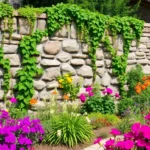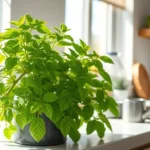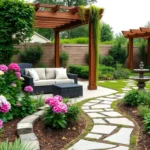We’ve all dreamed of escaping to those sun-drenched coastal regions where olive trees sway gently in warm breezes and lavender fills the air with its intoxicating fragrance. The good news? You don’t need a passport to bring that Mediterranean magic to your own backyard.
Creating a Mediterranean garden transforms your outdoor space into a stunning oasis that’s both drought-resistant and incredibly beautiful. These gardens celebrate the natural beauty of Southern Europe with their signature combination of aromatic herbs, silvery foliage, and vibrant blooms that thrive in sunny conditions.
Whether you’re working with a sprawling industry or a cozy patio space, we’ll show you how to capture that effortless Mediterranean charm. From selecting the perfect plants to incorporating authentic design elements, you’ll discover practical ideas that’ll transport you to the hillsides of Tuscany every time you step outside.
Choose Drought-Tolerant Plants for Your Mediterranean Garden
Selecting the right plants forms the foundation of any successful Mediterranean garden. These hardy specimens thrive in sunny conditions while requiring minimal water once established.
Lavender and Rosemary for Fragrant Borders
Lavender creates stunning purple borders that release intoxicating scents throughout your garden space. We recommend planting English lavender varieties like ‘Hidcote’ or ‘Munstead’ along pathways where visitors can brush against the fragrant foliage. These perennial herbs bloom from late spring through summer and attract beneficial pollinators like bees and butterflies.
Rosemary serves as an excellent companion plant that provides year-round structure with its needle-like evergreen leaves. Upright varieties such as ‘Tuscan Blue’ can reach heights of 4-6 feet, making them perfect for creating natural screens or backdrop plantings. We’ve found that both herbs require well-draining soil and full sun exposure to flourish in Mediterranean garden settings.
Olive Trees as Statement Pieces
Olive trees anchor Mediterranean gardens with their distinctive silvery-green foliage and gnarled trunk character. We suggest choosing varieties like ‘Arbequina’ or ‘Picual’ that adapt well to container growing if you’re working with smaller spaces. These trees develop slowly but eventually create stunning focal points that can live for decades with proper care.
Positioning olive trees requires consideration of their mature size and sun requirements. Place them where they’ll receive at least 6-8 hours of direct sunlight daily and ensure adequate drainage to prevent root rot. We often recommend planting them in raised beds or containers filled with Mediterranean-style soil mix that includes gravel and sand.
Succulents and Cacti for Low-Maintenance Appeal
Succulents bring architectural interest to Mediterranean gardens while requiring virtually no supplemental watering once established. Agave plants like ‘Blue Glow’ or ‘Whale’s Tongue’ create dramatic sculptural elements that pair beautifully with Mediterranean color schemes. These plants store water in their thick leaves, making them perfect for hot, dry conditions.
Cacti varieties such as prickly pear or barrel cacti add authentic desert charm to your Mediterranean industry design. We recommend grouping different succulent sizes and textures together to create visually appealing compositions that remain attractive throughout all seasons. These plants typically need protection from excessive winter moisture in most climates.
Create Natural Stone Pathways and Terracing
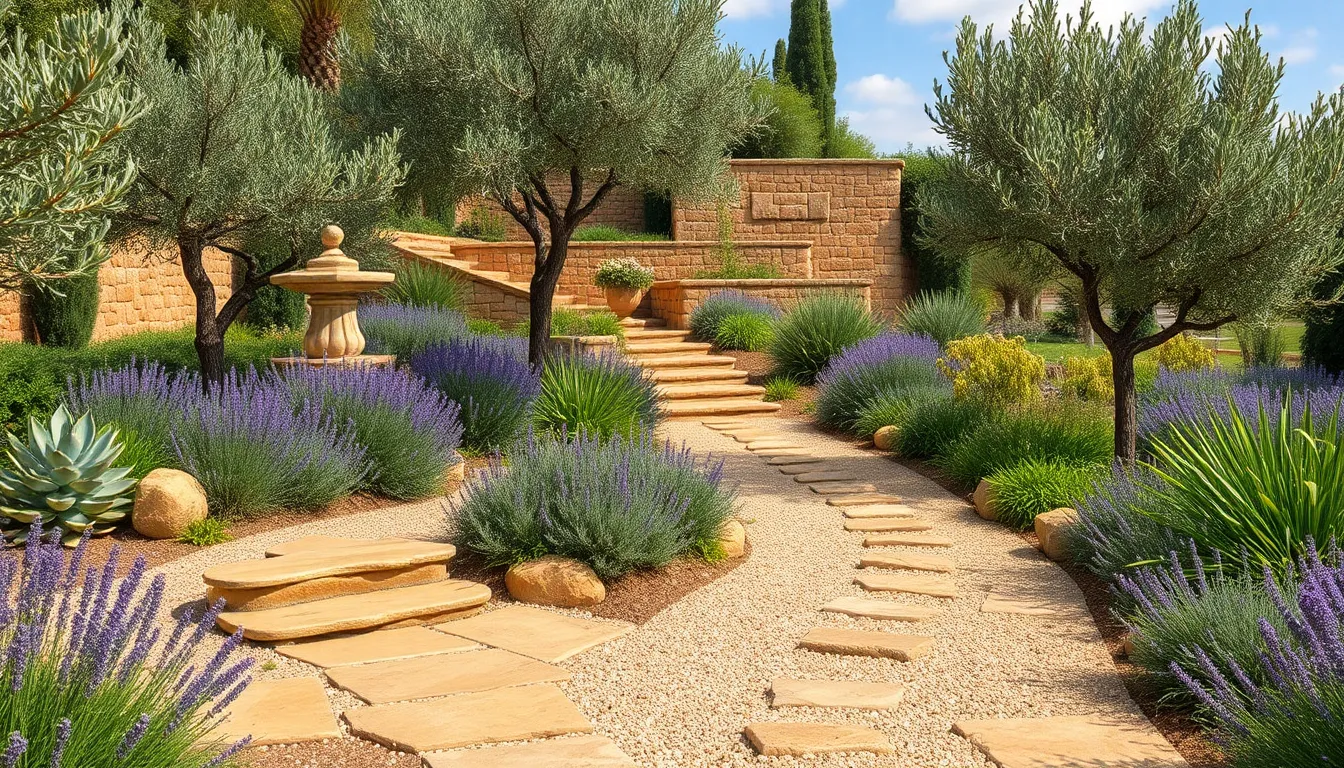
Natural stone pathways and terracing form the structural backbone of authentic Mediterranean gardens. We’ll explore how these elements work together to create that timeless Mediterranean charm you’re seeking.
Limestone and Travertine for Authentic Appeal
Limestone and travertine offer unmatched authenticity for Mediterranean garden design. These natural stones deliver the warm, earthy tones that define traditional Mediterranean landscapes. We recommend using limestone for your main pathways since it provides excellent durability while maintaining that weathered, time-worn appearance.
Travertine works beautifully for both paving and wall cladding applications. Its natural texture and neutral coloring complement Mediterranean plantings like olive trees and lavender perfectly. Both stones develop an attractive patina over time, adding character and depth to your garden’s overall aesthetic.
Gravel Paths Between Planted Areas
Gravel paths create essential texture contrast throughout your Mediterranean garden design. We suggest installing these rustic pathways between your planted areas to achieve that casual, relaxed atmosphere typical of Mediterranean outdoor spaces. Gravel provides excellent drainage, which suits both the Mediterranean climate and your drought-resistant plant selections.
These paths require minimal maintenance while highlighting your lush greenery and vibrant flowers. We find that gravel pathways work exceptionally well around succulents, rosemary, and bougainvillea plantings. The neutral tones of gravel allow your Mediterranean plants to take center stage while providing practical walking surfaces.
Retaining Walls for Sloped Gardens
Retaining walls constructed from natural stone serve dual purposes in Mediterranean garden design. We use these walls to prevent erosion while creating level terraces for planting and outdoor living spaces. Stone retaining walls become structural focal points that tie your entire garden design together.
These walls enable us to transform challenging sloped areas into functional Mediterranean terraces. Natural stone construction maintains authenticity while providing the structural support needed for your olive trees, herbs, and other Mediterranean plantings. We recommend incorporating these walls as both practical answers and aesthetic features that enhance your garden’s Mediterranean appeal.
Install Water Features That Reflect Mediterranean Style
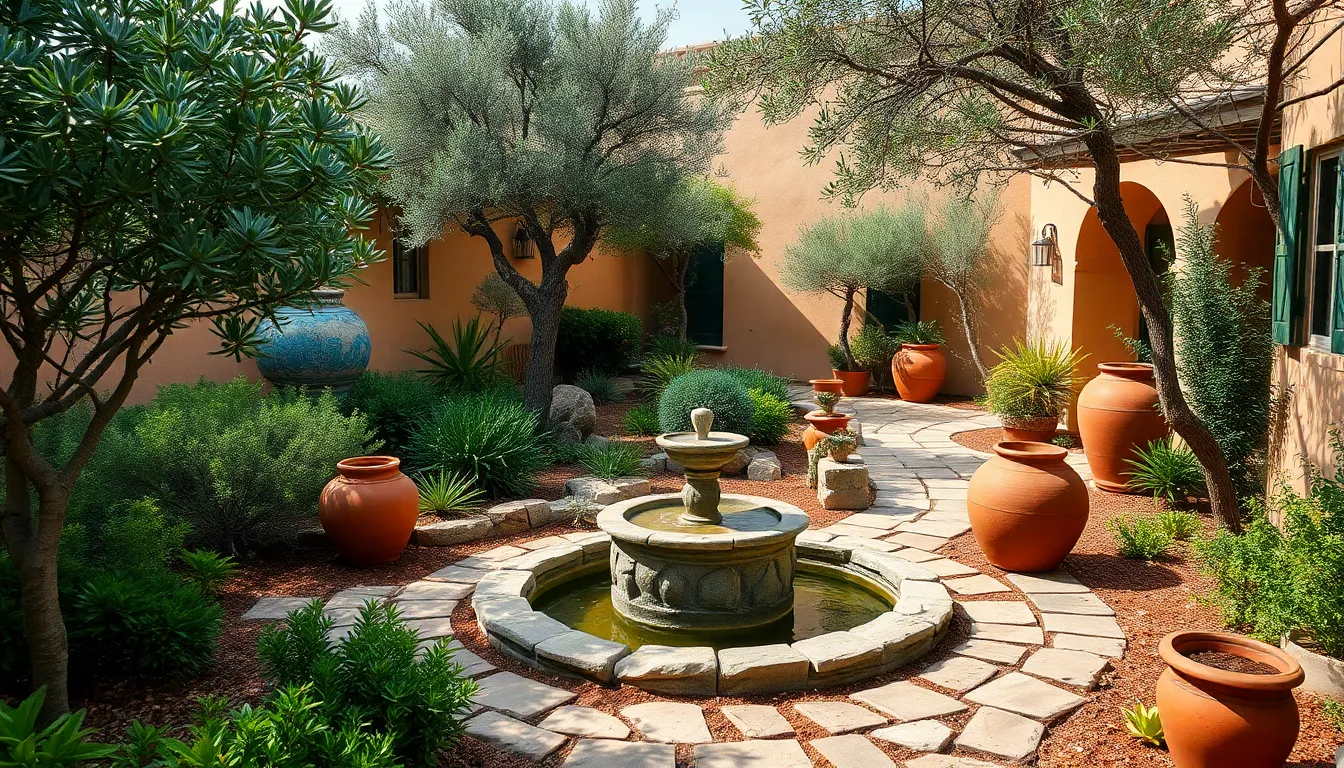
Water elements bring the soothing sounds and cooling effects that make Mediterranean gardens so inviting. We’ll explore three essential water features that capture this timeless aesthetic.
Small Fountains as Focal Points
Small fountains create elegant centerpieces that instantly transform any garden space into a Mediterranean retreat. We recommend positioning these water features at the intersection of pathways or as terminating points for garden views to maximize their visual impact. Traditional Mediterranean fountains often feature simple geometric shapes with gentle water flow that produces relaxing sounds without overwhelming the peaceful atmosphere.
Stone or ceramic materials work best for authentic Mediterranean fountain designs. We suggest choosing fountains with weathered finishes that complement your natural stone pathways and blend seamlessly with drought-resistant plantings. Compact wall-mounted fountains provide excellent options for smaller spaces while still delivering the classic Mediterranean ambiance.
Reflecting Pools for Tranquil Spaces
Reflecting pools offer serene mirror-like surfaces that double the visual impact of surrounding olive trees and architectural elements. We position these shallow water features to capture reflections of the sky and nearby plantings, creating depth and tranquility in the garden design. These pools work particularly well in formal Mediterranean garden layouts where symmetry and balance are key design principles.
Rectangular or circular shapes align perfectly with traditional Mediterranean aesthetics. We recommend keeping the water depth between 6 to 12 inches for optimal reflection while ensuring easy maintenance. Natural stone coping around the pool edges creates seamless integration with your limestone pathways and travertine paving elements.
Terra Cotta Water Vessels
Terra cotta pots transformed into water vessels add rustic Mediterranean charm while providing versatile placement options throughout the garden. We use these earthenware containers as standalone water features or incorporate them into fountain designs for authentic Old Industry appeal. Large terra cotta urns can serve as bubbling water basins while smaller vessels create intimate water accents near seating areas.
Weathered terra cotta surfaces develop beautiful patina over time that enhances the Mediterranean character. We recommend grouping vessels of varying sizes to create visual interest and complement your succulent and cacti displays. These portable water features allow flexibility in garden design and can be relocated seasonally to refresh the overall composition.
Design Outdoor Living Spaces for Entertaining
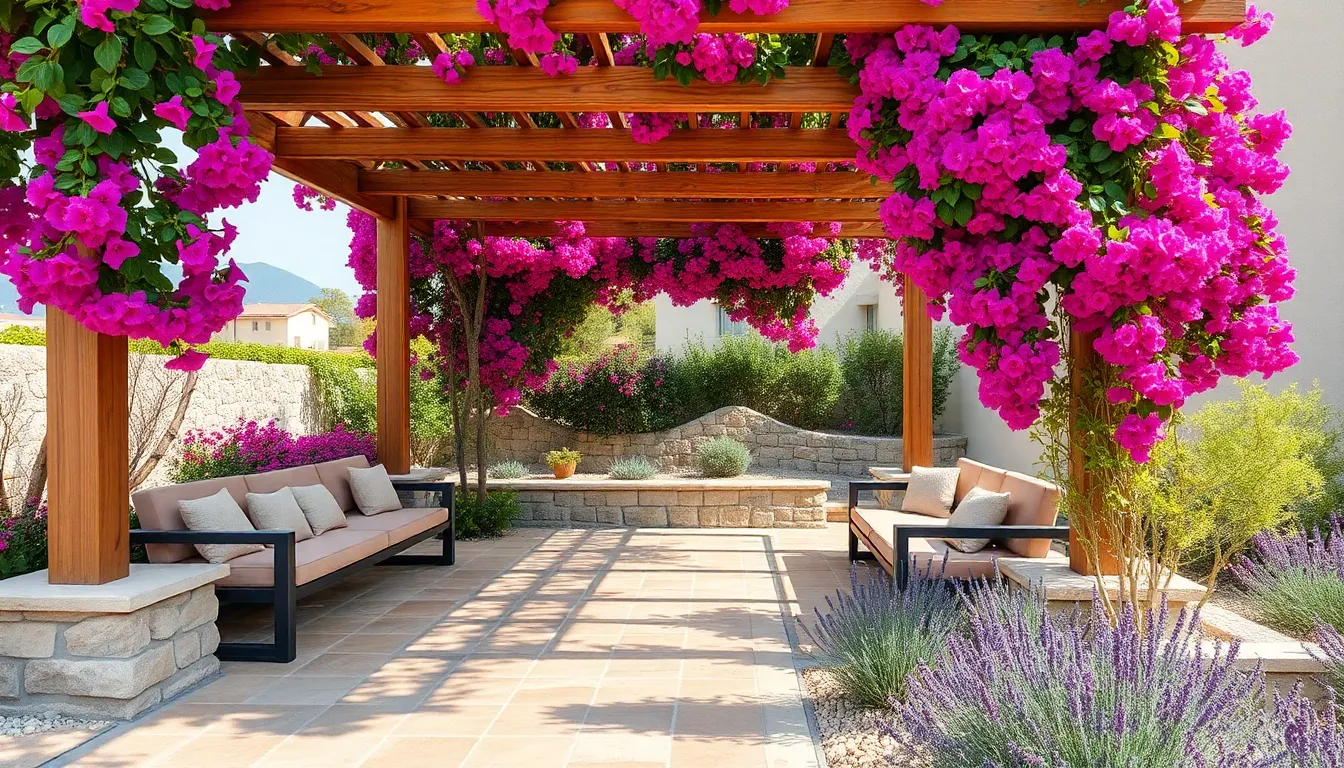
Creating functional outdoor entertaining areas transforms our Mediterranean garden into an extension of our home where family and friends naturally gather.
Pergolas with Climbing Vines
Pergolas serve as stunning focal points that define our entertaining spaces while providing essential shade coverage. We recommend positioning these structures over dining areas or seating zones to create natural outdoor rooms. Bougainvillea offers vibrant blooms in pink, purple, or white that cascade beautifully over pergola beams, while grapevines provide edible harvests alongside their lush green canopy.
Training climbing vines requires initial guidance with wire supports, but they quickly establish themselves to create living architecture. The partial shade these structures provide makes outdoor dining comfortable during peak sun hours. Mediterranean gardens benefit from pergolas because they blur the lines between indoor and outdoor living spaces.
Stone or Tile Patios
Stone patios anchor our entertaining areas with durable surfaces that complement Mediterranean aesthetics perfectly. Limestone creates warm, weathered appearances that improve with age, while travertine offers elegant neutral tones that stay cool underfoot. Terracotta tiles bring earthy warmth and traditional Mediterranean character to dining and seating areas.
These materials withstand weather extremes while requiring minimal maintenance compared to wooden decking. We suggest incorporating different textures by combining smooth stone with rougher surfaces for visual interest. Gravel borders around patios provide excellent drainage while creating natural transitions between hardscape and planted areas.
Built-In Seating Areas
Built-in seating maximizes our entertaining capacity while maintaining clean design lines throughout the garden. Stone or concrete benches integrate seamlessly with retaining walls and planter boxes, creating cohesive outdoor furniture that never needs storing. We recommend surrounding these seating areas with fragrant plants like lavender and rosemary for sensory appeal.
Comfortable cushions and pillows in vibrant Mediterranean colors transform utilitarian seating into inviting gathering spots. Built-in designs save space compared to movable furniture while providing permanent answers for large groups. Strategic placement near focal points like fountains or olive trees enhances the overall ambiance of our entertaining spaces.
Incorporate Traditional Mediterranean Colors and Textures
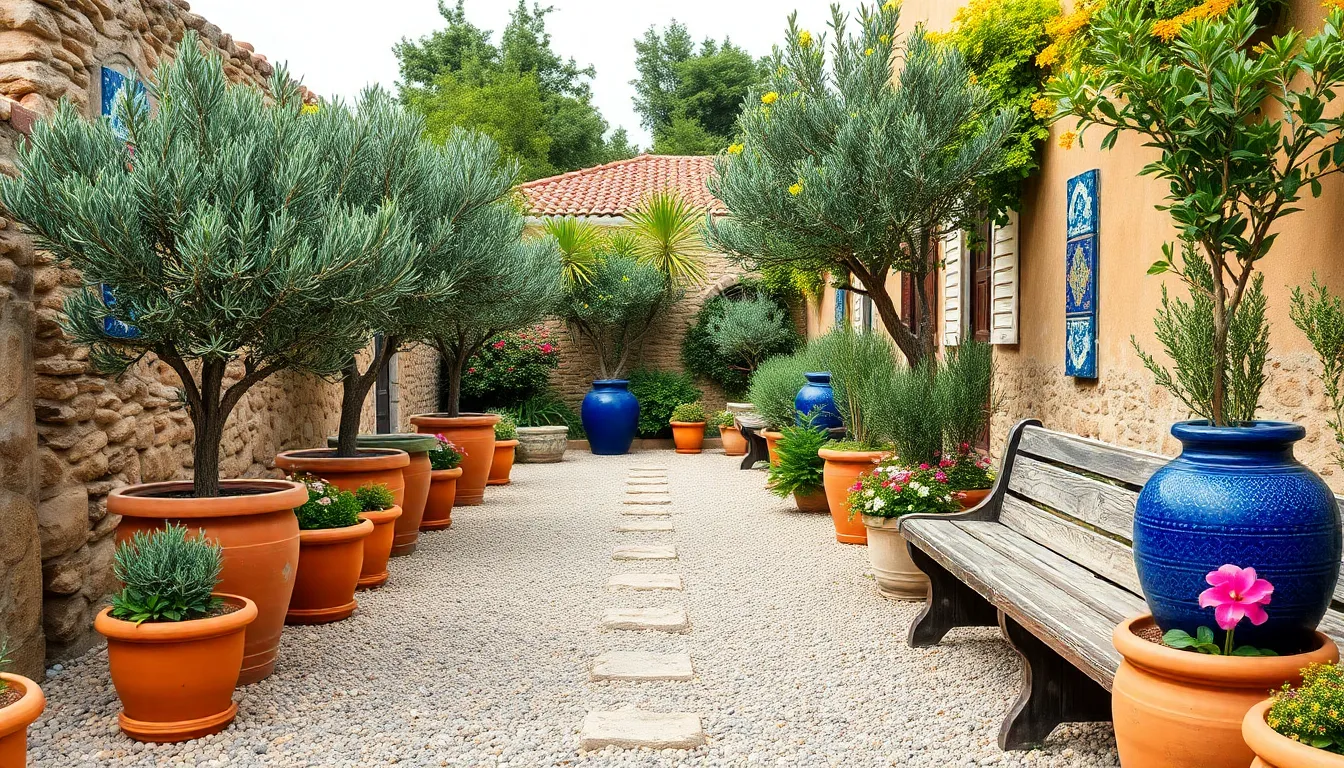
Creating an authentic Mediterranean garden requires thoughtful attention to the region’s signature color palette and natural textures. We’ll explore how to weave together earthy tones, sea-inspired blues, and weathered materials to capture the essence of Southern European landscapes.
Warm Earth Tones for Hardscaping
Gravel flooring creates the perfect foundation for your Mediterranean garden pathways, offering both practical drainage and visual appeal. Stone pathways complement this approach beautifully, using materials that echo the warm, sun-baked landscapes of the Mediterranean coast. We recommend selecting limestone or travertine for these walkways, as their natural weathering creates an authentic aged appearance over time.
Terracotta elements bring instant Mediterranean charm to any outdoor space. Large terracotta pots serve as stunning focal points for olive trees or rosemary plantings, while smaller vessels can house succulents along pathway edges. Rough-hewn stone walls and weathered brick features add textural depth, creating the perfect backdrop for your Mediterranean plantings.
Natural stone retaining walls serve dual purposes in Mediterranean garden design. They prevent erosion on sloped terrain while creating level terraces that maximize planting opportunities. Choose materials like sandstone or limestone that develop beautiful patina as they age, improving the garden’s authentic Mediterranean character.
Blue Accents Inspired by the Sea
Cobalt blue accents transform ordinary garden elements into Mediterranean treasures that evoke coastal memories. We suggest incorporating these vibrant blues through decorative planters, outdoor cushions, and ceramic tiles placed strategically throughout your space. These bold color pops create stunning contrasts against the warm earth tones of your hardscaping.
Reflective water features amplify the blue accent theme while adding tranquil sounds to your garden. Small fountains with cobalt blue ceramic details serve as elegant focal points, particularly when positioned at pathway intersections. Consider adding blue-tiled reflecting pools that mirror the sky, creating depth and visual interest in formal garden layouts.
Decorative elements like blue ceramic wind chimes, painted wooden shutters, or glazed pottery bring the Mediterranean color palette to life. These accessories work best when distributed thoughtfully rather than clustered, allowing each blue accent to make its own statement against the neutral backdrop.
Weathered Wood Elements
Weathered wood planters add warmth and character to Mediterranean gardens while providing excellent growing conditions for herbs and flowers. We recommend using cedar or teak planters that naturally develop silver-gray patina over time, perfectly complementing the garden’s earth tone palette. These containers work especially well for mobile herb gardens that can be repositioned seasonally.
Wooden benches crafted from reclaimed or naturally weathered timber create inviting seating areas throughout your Mediterranean space. Position these benches near fragrant plantings like lavender or rosemary to enhance the sensory experience. The wood’s natural aging process adds authentic Mediterranean charm while requiring minimal maintenance.
Pergola structures built with weathered wood beams provide essential shade while supporting climbing Mediterranean plants. Choose materials that complement your existing hardscaping, allowing the wood to weather naturally for the most authentic appearance. These structures serve as outdoor rooms that extend your living space into the garden.
Add Aromatic Herb Gardens for Culinary Use
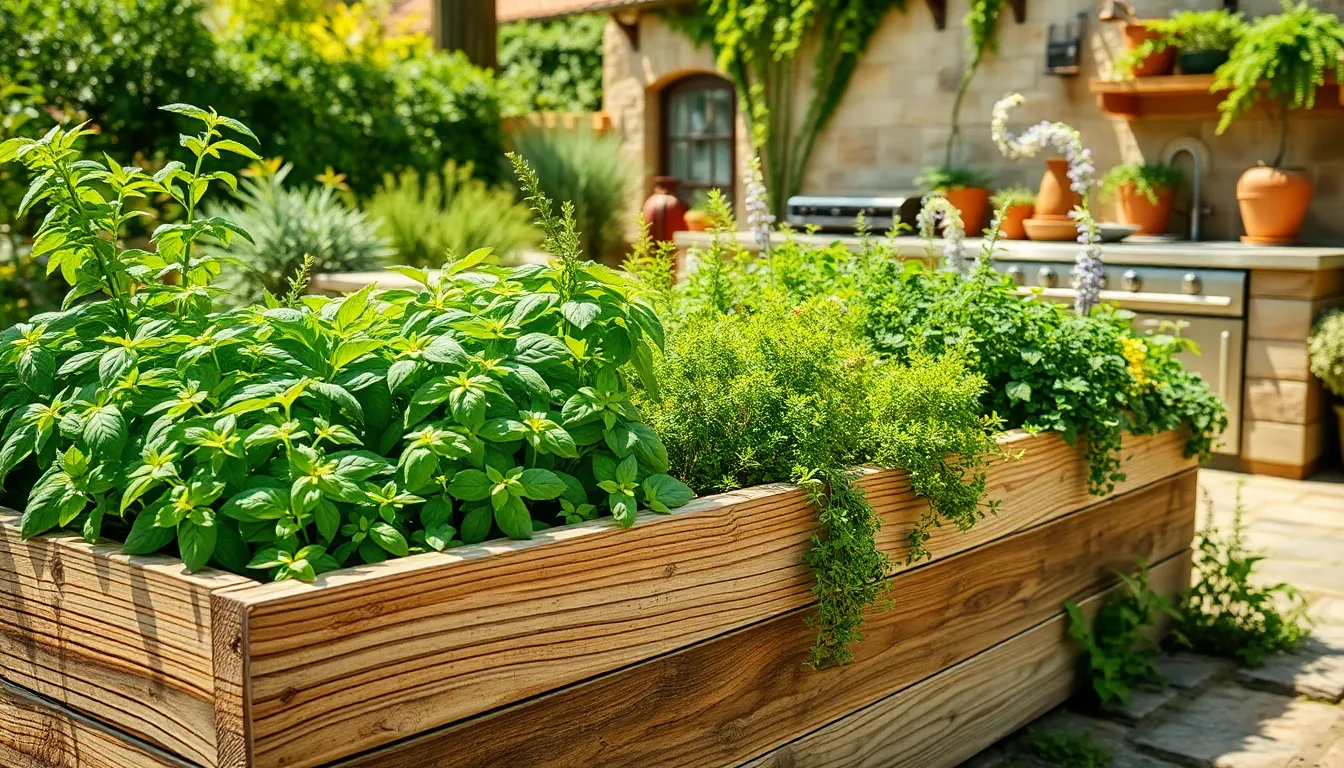
Mediterranean gardens aren’t complete without fragrant herb gardens that bring authentic culinary flavors to your outdoor space. We can transform our garden into a functional cooking paradise by incorporating essential Mediterranean herbs that thrive in sunny, well-drained conditions.
Basil, Oregano, and Thyme Clusters
Basil clusters form the foundation of Mediterranean herb gardening, offering sweet and peppery flavors that define regional cuisine. We should plant multiple basil varieties like Genovese, Greek, and purple basil together to create aromatic clusters that release their fragrance with every breeze. These tender annuals require warm temperatures and consistent moisture to produce abundant leaves throughout the growing season.
Oregano patches provide robust, earthy flavors that complement tomato-based dishes and grilled meats perfectly. We can establish oregano clusters by planting different varieties such as Greek oregano, Turkish oregano, and sweet marjoram in close proximity. This perennial herb spreads naturally through underground runners, creating dense aromatic carpets that require minimal maintenance once established.
Thyme groupings offer woody, lemony scents that enhance both cooking and garden aesthetics throughout the year. We should combine common thyme with lemon thyme and creeping thyme to create textural variety while maintaining consistent culinary value. These hardy perennials tolerate drought conditions exceptionally well and develop into compact, silvery-green mounds that complement Mediterranean hardscaping materials.
Raised Planters for Easy Access
Elevated herb beds allow us to maintain and harvest our culinary herbs without bending or kneeling repeatedly. We can construct raised planters using natural materials like stone, terracotta, or weathered wood that complement our Mediterranean garden’s aesthetic. These planters should measure 18-24 inches in height to provide comfortable access while ensuring adequate soil depth for root development.
Strategic placement of raised planters near outdoor kitchens or dining areas creates convenient herb access during meal preparation. We should position these elevated beds within 10-15 feet of our cooking spaces to encourage frequent harvesting and use. The proximity also allows us to appreciate the aromatic qualities of our herbs while entertaining guests in our Mediterranean outdoor living areas.
Drainage considerations become crucial when designing raised herb planters in Mediterranean-style gardens. We must incorporate gravel layers at the bottom of each planter and use well-draining soil mixtures that prevent waterlogged conditions. This drainage system mimics the natural rocky soils found in Mediterranean regions where these herbs originally thrived.
Kitchen Garden Integration
Seamless design connects our aromatic herb gardens with existing Mediterranean garden elements through thoughtful layout planning. We can integrate raised herb planters alongside stone pathways, water features, and seating areas to create functional garden zones. This integration ensures our culinary herbs become essential components of our overall Mediterranean garden design rather than separate afterthoughts.
Companion planting strategies allow us to combine herbs with Mediterranean vegetables like tomatoes, peppers, and eggplants in shared raised beds. We should group basil near tomato plants to enhance flavor development while oregano and thyme can border pepper varieties effectively. These combinations create productive kitchen gardens that supply fresh ingredients for authentic Mediterranean meals.
Year-round accessibility requires planning our kitchen garden integration to accommodate seasonal changes in herb growth and harvest cycles. We can install temporary cold frames or protective covers over raised planters during cooler months to extend growing seasons. This approach ensures continuous access to fresh herbs while maintaining the Mediterranean garden’s visual appeal throughout different seasons.
Use Large Containers and Planters Strategically
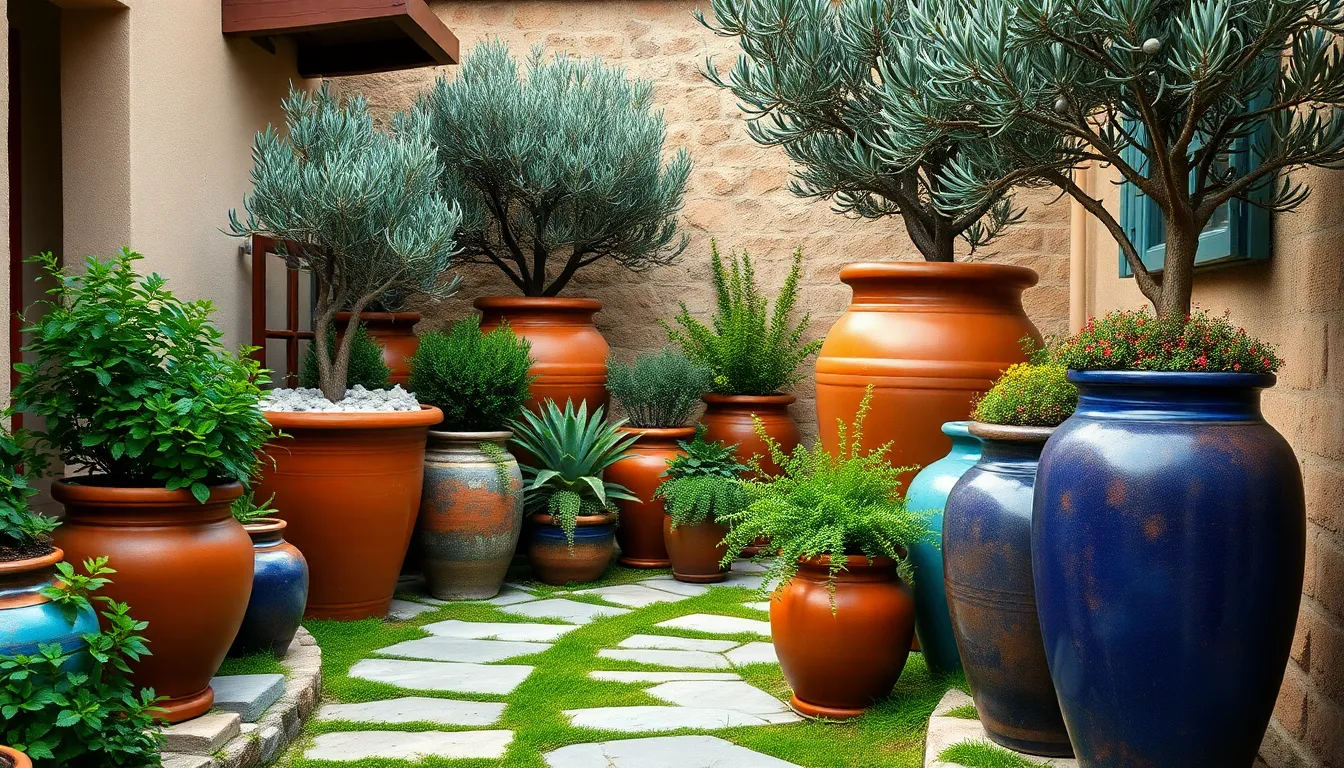
Strategic placement of large containers transforms any Mediterranean garden into a structured, visually appealing oasis. We can create garden rooms and define focal points by positioning substantial planters near seating areas, along pathways, or at entry points to enhance the overall aesthetic.
Terra Cotta Pots in Various Sizes
Terra cotta pots bring authentic Mediterranean warmth with their natural orange hue that adds texture and character to garden spaces. We recommend using various sizes to create depth and visual interest throughout your outdoor area. Small pots work perfectly for aromatic herbs like basil and thyme, while larger vessels can accommodate olive trees or citrus plants that serve as striking focal points.
The porous nature of terra cotta provides excellent drainage for Mediterranean plants that thrive in well-drained, airy soil conditions. Clustering different sized pots creates natural groupings that mimic the informal, layered look characteristic of authentic Mediterranean gardens. We suggest placing larger terra cotta containers at corners or pathway intersections to anchor the garden’s design.
Glazed Ceramic Vessels
Glazed ceramic vessels introduce vibrant splashes of color that contrast beautifully with warm terra cotta tones. We often choose vessels in classic Mediterranean hues like cobalt blue, sage green, and rich earth tones to complement the garden’s natural palette. These colorful containers work exceptionally well as accent pieces that highlight special plants or draw attention to exact garden corners.
Positioning glazed vessels strategically throughout the space prevents visual monotony while maintaining the Mediterranean aesthetic. We recommend using them sparingly as statement pieces rather than overwhelming the garden with too many bright colors. Their smooth, reflective surfaces create interesting textural contrasts against the rougher terra cotta and natural stone elements.
Grouping Techniques for Visual Impact
Grouping containers together creates powerful visual statements that simulate the lush, informal feel typical of Mediterranean gardens. We combine pots of different sizes, textures, and materials to prevent monotony while maintaining cohesive design principles. Successful groupings often feature a large olive tree in a substantial terra cotta pot surrounded by smaller glazed vessels containing rosemary and lavender.
Creating these textured and fragrant vignettes requires balancing scale and color throughout the arrangement. We recommend including drought-tolerant plants like succulents, cacti, and flowering Mediterranean natives in your container groupings. Positioning these clusters near outdoor seating areas enhances the sensory experience while providing natural privacy screens and conversation focal points.
Create Shade Solutions for Hot Climate Comfort
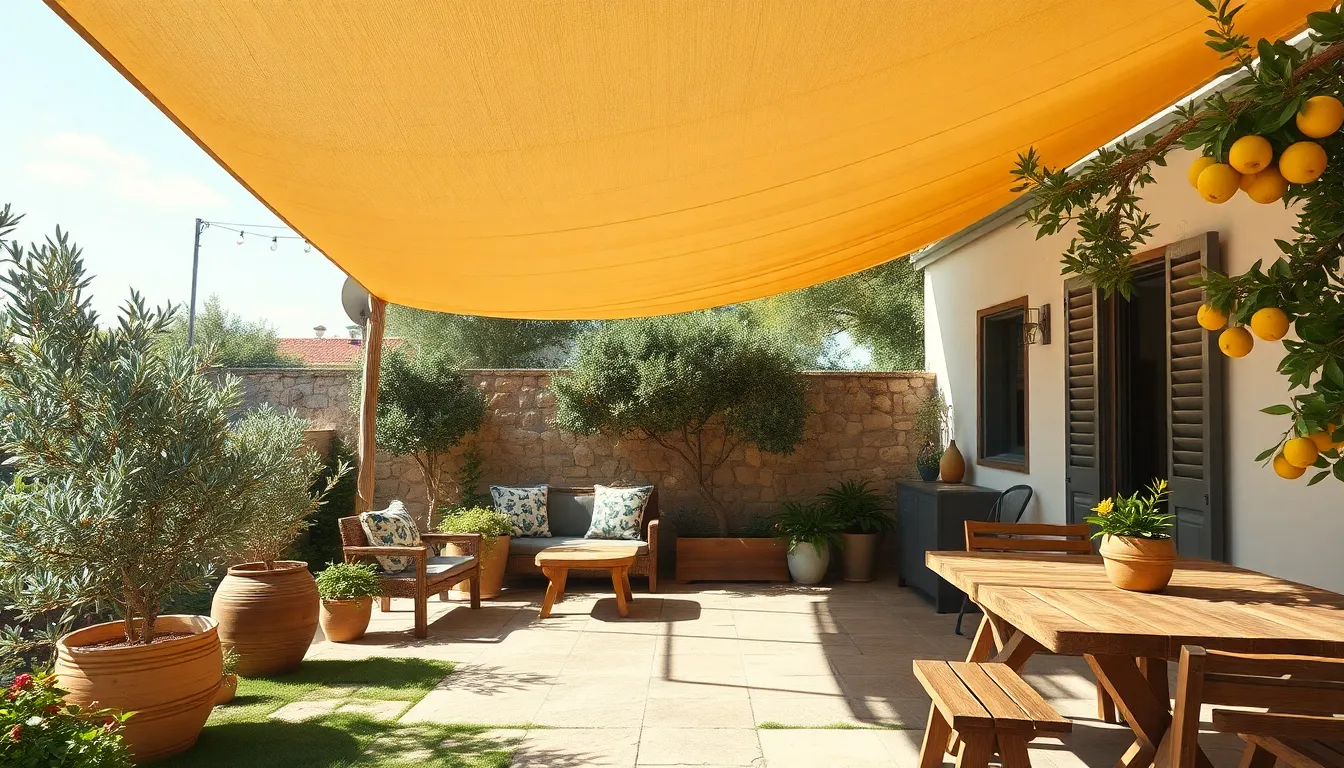
Mediterranean climates demand thoughtful shade planning to ensure our outdoor spaces remain comfortable during intense summer heat. We’ll explore three effective approaches that combine functionality with authentic Mediterranean style.
Sail Cloth and Canvas Canopies
Sail cloth canopies offer our Mediterranean gardens lightweight protection that’s both easy to install and visually stunning. We recommend positioning these triangular or rectangular fabric panels between sturdy anchor points like pergola posts or established trees. Canvas materials provide excellent UV protection while allowing gentle breezes to flow through, creating comfortable microclimates beneath.
Strategic placement of these canopies transforms harsh sunny areas into inviting outdoor gathering spaces. We can adjust their height and angle seasonally, ensuring optimal shade coverage as the sun’s path changes throughout the year. Multiple canopies create layered protection over larger entertaining areas, while single installations work perfectly for intimate seating nooks.
Natural Tree Canopies
Native Mediterranean trees serve as our gardens’ most elegant and sustainable shade providers. Olive trees create distinctive silvery canopies that filter sunlight beautifully while maintaining the region’s authentic character. Lemon and other citrus trees offer dual benefits of fragrant blossoms and productive harvests alongside their cooling shade.
We position these trees strategically to shade key outdoor living areas during peak afternoon hours. Mature specimens provide substantial coverage, while younger plantings offer growing shade that improves each season. Fig trees and pomegranates extend our natural canopy options, contributing both shade and Mediterranean fruit production to our garden network.
Covered Dining Areas
Pergolas create permanent outdoor dining rooms that define entertaining spaces within our Mediterranean gardens. We construct these structures using weathered wood beams or natural stone columns that complement existing hardscaping materials. Climbing vines like grapevines and bougainvillea eventually create living roofs that provide filtered shade and seasonal interest.
Gazebos offer more substantial weather protection for our outdoor dining investments. We select designs that incorporate Mediterranean architectural elements like arched openings and terra cotta tile accents. These covered structures allow us to extend outdoor entertaining seasons while protecting furniture and creating intimate gathering spaces that feel like natural extensions of our homes.
Conclusion
We’ve explored how transforming your outdoor space into a Mediterranean garden creates a perfect blend of beauty and functionality. From drought-resistant plants and aromatic herbs to natural stone pathways and refreshing water features these elements work together to establish an authentic atmosphere.
The key lies in combining practical design choices with traditional Mediterranean aesthetics. Whether you’re incorporating terra cotta containers weathered wood features or cobalt blue accents each element contributes to the overall charm and sustainability of your garden.
With proper planning and the right combination of plants hardscaping and outdoor living spaces you’ll create a stunning retreat that brings the warmth and elegance of the Mediterranean directly to your backyard. Your new garden will serve as both a peaceful sanctuary and an inviting space for entertaining year-round.
Frequently Asked Questions
What plants are best for a Mediterranean garden?
The foundation of a Mediterranean garden includes drought-resistant plants like lavender, rosemary, and olive trees. Succulents and cacti are excellent low-maintenance options that thrive in hot, dry conditions. Aromatic herbs such as basil, oregano, and thyme work perfectly in sunny, well-drained areas and provide both fragrance and culinary benefits.
What materials should I use for Mediterranean garden pathways?
Limestone is ideal for main pathways due to its durability and naturally weathered appearance. Travertine works well for paving and wall cladding, while gravel paths offer rustic charm and excellent drainage. These natural stone materials create an authentic Mediterranean aesthetic while providing practical functionality.
How can I add water features to my Mediterranean garden?
Consider incorporating small fountains at pathway intersections as elegant focal points. Reflecting pools create serene mirror-like surfaces that add depth and tranquility. Terra cotta water vessels provide rustic charm and versatility, allowing creative placement throughout your garden while maintaining the Mediterranean theme.
What shade solutions work best in Mediterranean gardens?
Sail cloth and canvas canopies offer lightweight protection with aesthetic appeal. Plant native Mediterranean trees like olive and citrus for natural, sustainable shade. Pergolas and gazebos create defined outdoor dining areas, extending your entertaining season while providing essential relief from hot climates.
How do I create authentic Mediterranean colors and textures?
Use warm earth tones for hardscaping materials like gravel and stone pathways. Incorporate terracotta elements and weathered wood features for authenticity. Add cobalt blue accents through decorative planters and tiles to evoke coastal memories, while weathered wood pergolas provide both shade and character.
What containers work best for Mediterranean gardens?
Terra cotta pots in various sizes provide authentic warmth and excellent drainage. Glazed ceramic vessels add colorful accents that contrast beautifully with terra cotta. Group different sizes, textures, and materials together to create impactful visual statements and simulate the lush, informal Mediterranean garden feel.



